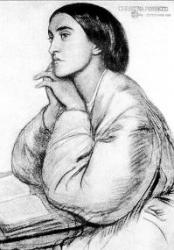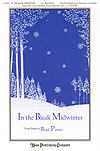- |
User Links
In the Bleak Midwinter

In the bleak midwinter
Author: Christina Georgina Rossetti (c. 1872)Tune: CRANHAM
Scripture Songs
Published in 97 hymnals
Playable presentation: Lyrics only, lyrics + musicAudio files: MIDI, Recording
Representative Text
1 In the bleak midwinter
frosty wind made moan,
earth stood hard as iron,
water like a stone:
snow had fallen,
snow on snow, snow on snow,
in the bleak midwinter,
long ago.
2 Our God, heaven cannot hold him,
nor earth sustain;
heaven and earth shall flee away
when he comes to reign:
in the bleak midwinter
a stable place sufficed
the Lord God Almighty,
Jesus Christ.
3 Enough for him whom cherubim
worship night and day,
a breastful of milk
and a mangerful of hay:
enough for him
whom angels fall down before,
the ox and ass and camel
which adore.
4 Angels and archangels
may have gathered there,
cherubim and seraphim
thronged the air,
but only his mother,
in her maiden bliss,
worshiped the Beloved
with a kiss.
5 What can I give him,
poor as I am?
If I were a shepherd,
I would bring a lamb,
if I were a wise man
I would do my part,
yet what I can I give him,
give my heart.
Church Hymnary (4th ed.) (2005)
Author: Christina Georgina Rossetti
 Rossetti, Christina Georgina, daughter of Gabriel, and sister of Dante Gabriel and William Michael Rossetti, was born in London, Dec. 5, 1830, and received her education at home. Her published works include:—
(1) Goblin Market, and Other Poems, 1862; (2) The Prince's Progress, and Other Poems, 1866 ; (3) Poems, mainly a reprint of Nos. 1 and 2, 1875; (4) A Pageant, and Other Poems, 1881, &c.
In addition, Miss Rossetti has published several prose works, as:— Annus Domini (a book of prayers for every day in the year), 1874; Letter and Spirit of the Decalogue, 1883, and others. She has written very few hymns avowedly for church worship, but several centos have been compiled from her poems, and have passed into several hymn-books. The… Go to person page >
Rossetti, Christina Georgina, daughter of Gabriel, and sister of Dante Gabriel and William Michael Rossetti, was born in London, Dec. 5, 1830, and received her education at home. Her published works include:—
(1) Goblin Market, and Other Poems, 1862; (2) The Prince's Progress, and Other Poems, 1866 ; (3) Poems, mainly a reprint of Nos. 1 and 2, 1875; (4) A Pageant, and Other Poems, 1881, &c.
In addition, Miss Rossetti has published several prose works, as:— Annus Domini (a book of prayers for every day in the year), 1874; Letter and Spirit of the Decalogue, 1883, and others. She has written very few hymns avowedly for church worship, but several centos have been compiled from her poems, and have passed into several hymn-books. The… Go to person page >Text Information
Related Texts
| First Line: | In the bleak midwinter |
| Title: | In the Bleak Midwinter |
| Author: | Christina Georgina Rossetti (c. 1872) |
| Meter: | Irregular |
| Place of Origin: | England |
| Language: | English |
| Copyright: | Public Domain; Public Domain |
| Liturgical Use: | Scripture Songs |
| Article: | "In the Bleak Midwinter" by Mary Kay Beall (from The Hymn) |
- Year A, Christmas season, Christmas Eve
This is recommended for Year A, Christmas season, Christmas Eve by 2 hymnal lectionary indexes including Glory to God: the Presbyterian Hymnal #144. - Year B, Advent, First Sunday
- Year C, Advent, Third Sunday
This is recommended for Year C, Advent, Third Sunday by 2 hymnal lectionary indexes including Glory to God: the Presbyterian Hymnal #144. - Year C, Advent, Fourth Sunday
- Year C, Christmas season, Christmas Eve
This is recommended for Year C, Christmas season, Christmas Eve by 2 hymnal lectionary indexes including Glory to God: the Presbyterian Hymnal #144.
Notes
Access an additional article on the Canterbury Dictionary of Hymnology:
For Leaders
Text:
The January 1872 edition of Scribner's Monthly was the first publication of Christina Rossetti's poem “A Christmas Carol.” The poem was later titled “In the Bleak Midwinter” after the opening line and published as a hymn in the English Hymnal in 1906. The full text has five stanzas, but the original third stanza (beginning “Enough for him”) is often omitted, and a few hymnals use the final stanza alone, titled “What Can I Give Him?”
As many other artists have done, Rossetti depicted the birth of Christ as taking place in a frozen, snowy English winter instead of the milder climate of Palestine where He was actually born. Despite the historical inaccuracy, her text effectively communicates the vast difference between the glory of heaven from which Jesus came and the reality of discomfort on earth, where He would eventually be crucified. The final stanza asks for an appropriate response to Christ's sacrifice of glory, and the answer is “give [him] my heart.”
Tune:
The only tune to which the complete hymn is sung is CRANHAM by a well-known English composer, Gustav Holst, who composed it for this text. (“What Can I Give Him?” is sometimes sung to another tune.) With a mood well-suited to the text, CRANHAM was first published in the English Hymnal in 1906.
The irregular meter of the text presents difficulties in fitting it to a tune. Holst's melody can be adapted to extra syllables by adding a pickup note to a phrase or dividing the long penultimate note of each phrase. A clear indication from the leader or choir on the placement of syllables should facilitate congregational singing. The tune is best sung in harmony.
When/Why/How:
This hymn is sung at Christmas. Because of the irregularity of the text and the fact that it is only sung once a year, it may be best to have the choir sing it. Robert Kreutz has set "In the Bleak Midwinter" to original music in an a capella rendition. Using CRANHAM, this simple choral setting of "In the Bleak Midwinter" is for two-part choir and piano, with optional handbells. A rhythmically fresh treatment of the tune is a feature of this choral arrangement of "In the Bleak Midwinter." If it is desired that the congregation sing the hymn, try using an instrumental setting of CRANHAM as a prelude or offertory during the week or two before, so that they will at least be familiar with the tune. "Let Heaven and Nature Sing" has an easy setting for solo piano, while "I Heard the Bells on Christmas Day" includes an arrangement for organ. For handbells, there is a graceful, expressive setting of "In the Bleak Midwinter."
Tiffany Shomsky, Hymnary.org
Timeline
Arrangements
Media
- Audio recording from Church Hymnary (4th ed.) #305
- MIDI file from The Cyber Hymnal #3005
- Audio recording from Evangelical Lutheran Worship #294
- Audio recording from Glory to God: the Presbyterian Hymnal #144
- Audio recording from The Presbyterian Hymnal: hymns, psalms, and spiritual songs #36
- Audio recording from The United Methodist Hymnal #221
- MIDI file from The United Methodist Hymnal #221
- MIDI file from Worship and Rejoice #196


 My Starred Hymns
My Starred Hymns






